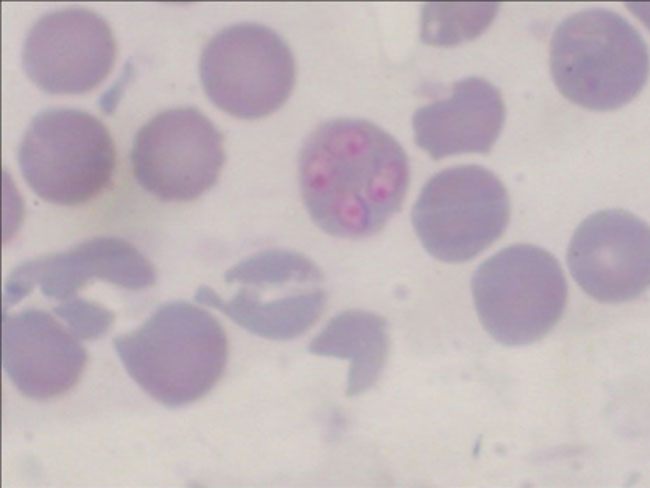Tick Fever is one of the most common and most dangerous diseases that happens in dogs in Hong Kong. As a pet owner, you should know more about the symptoms of tick fever and what we can do to prevent our furry friends from getting infected.
What is tick fever and how the dog get infected (Babesia)?
Babesia canis, Babesia Gibsoni and Ehrlichia Canis are the 3 most commonly seen tick-borne infections in Hong Kong. Today we would focus on the comparison of Babesia Canis and Babasia Gibsoni.
Babesia infection is a significant tick-borne disease caused by various species of Babesia organisms. In most of the cases, parasites are primarily transmitted through tick bites. Once the organisms get into the dog’s body, it would invade and attack their red blood cells, often leading to anemia.
However, Babesia Gibsoni may be transmitted directly by animal to animal, such as an infected dog with oral lesion or abrasions bite another dog, and infected pregnant females can also transmit babesia to their unborn puppies. Dogs may also be inadvertently infected through tainted blood transfusion. Because of potential of transmission through blood, all packed red blood cells (pRBCs) provided by Wellness Veterinary Hospital are tested for multiple infectious diseases including Babesia spp, to ensure the safety of blood recipients. Click here for more information.
What is the difference between Babesia Canis & Babesia Gibsoni?
Babesia Canis and Babesia Gibsoni are morphologically differentiated on the basis of their size in blood smear.
Babesia Canis – large form (4–5 μm long) of Babesia. Pyriform in shape, pointed one end, and round other. In a single RBC, multiple infection that is, more than one organism up to 16 may be found.
Babesia Gibsoni – small form (1.5–2.5 μm) of Babesia. Lack usual pyriform shapes, trophozoites are annular or oval; signet ring forms may occur.
Polymerase chain reaction (PCR)–based diagnostic assays have increased the detection rate of very low-level parasitemia as it can detect Babesia DNA. PCR test can be used for identification and differentiation of the various species of Babesia. This test is now one of the recommended laboratory tests for diagnosis for babesiosis because it is more sensitive and equally specific when compare with peripheral smear evaluation.
What are the symptoms?
In general, symptoms are less severe with Babesia Canis infection than with Babesia Gibsoni, even they have the similar clinical signs.
Dogs infected with babesia may present with a wide variety of symptoms ranging in severity from a sudden collapse with systemic shock, to a hemolytic crisis (the body attacks and destroys the red blood cells called hemolysis), to a subtle and slowly progressing infection with no apparent clinical signs.
Dogs also typically present with the acute, severe form of babesia, which is characterized by findings such as abnormally dark orange urine, fever, weakness, pale mucous membranes, depression, loss of appetite, swollen lymph nodes, and an enlarged spleen. Blood and urine tests may reveal anemia, thrombocytopenia (low platelets), hypoalbuminemia (low albumin, a blood protein), and bilirubinuria (a pigment from breaking down red blood cells is found in the urine).
How is babesiosis treated?
As mentioned before, Babesia organisms would destroy red blood cells in the body resulting in life-threatening anemia. Therefore, the treatment typically consists of three components:
- Blood transfusions to treat severe anemia.
- Antiprotozoal medications to help eliminate the parasite.
- Providing supportive care to treat the complications or side effects of the disease such as oxygen therapy to treat respiratory issues, or anti-nausea medication to help prevent vomiting.
Be aware that Babesia Gibson is considered more difficult to treat than Babesia Canis. Recommended treatment protocols for Babesia Gibsoni involve combining atovaquone (a quinone antimicrobial medication) and azithromycin(antibiotic).
What happens if untreated and how to prevent?
As mentioned, Babesia organisms destroy red blood cells in the body resulting in anemia. It can be fatal if left untreated too long. Therefore, prevention is very important.
The risk of infection can be reduced for dogs by providing tick control with a topical or oral acaricide, it’s better to consult your vet regarding the best possible way to keep your dog away from tick-borne infection. But no prevention is 100% protective, therefore it’s a good idea to inspect your dog for ticks on a regular basis by brushing your dog against the direction of the fur growth. If ticks are found, you should go to see vet as soon as possible.
Notes:
Wellness Veterinary Hospital provides packed red blood cell (pRBC) for dogs which is suitable with emergency, surgical and medical needs, please directly contact us at 2572 2088 for more details and information.
If you have any further queries about tick fever. Please contact us for more advice, or make an appointment here.
Source:
https://vcahospitals.com/know-your-pet/babesiosis-in-dogs
https://www.germantownah.com/site/blog-memphis-vet/2020/10/14/symptoms-treatment-babesiosis-in-dogs
https://www.vetfolio.com/learn/article/babesia-gibsoni-an-emerging-pathogen-in-dogs
https://www.sciencedirect.com/topics/agricultural-and-biological-sciences/babesia-canis
https://capcvet.org/guidelines/babesia/


